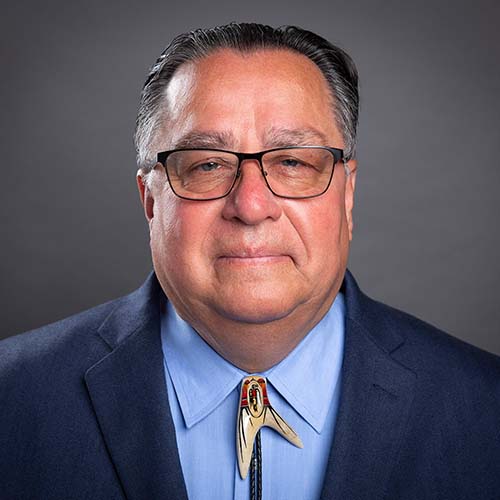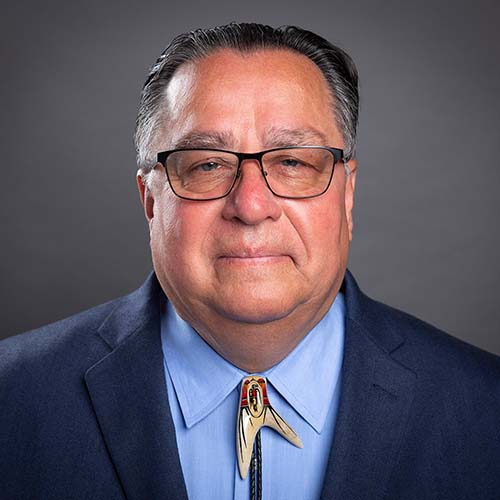
- Details
- By Levi Rickert
A 49-year survivor of incarceration within the United States prison system, Leonard Peltier (Ojibwe/Lakota), 80, is the most iconic Native American elder in Indian Country.
Peltier arrived home at the Turtle Mountain Indian Reservation on February 18 to a thunderous crowd of family, friends, and well-wishers who gathered as he crossed the reservation line.
After being wrongfully convicted of killing two FBI agents in June 1975, Peltier was granted clemency by President Joe Biden just before leaving office. He is now in home confinement for the rest of his life.
This past week, Shane Balkowitsch of Bismarck, North Dakota, who specializes in wet plate photography, captured several plates of the iconic figure.
The wet plate photography technique was the standard in photography between 1853 and 1880. It involves the historic wet plate collodion process, which uses silver on black glass.
For the past 12 years, Balkowitsch has used this process to capture images of Native Americans in a series called Northern Plains Native Americans: A Modern Wet Plate Perspective. His goal is to photograph 1,000 Native Americans—Peltier was number 862. So far, Baklowitsch has taken 5,335 plates of 862 Indigenous men and women from all over Indian Country.
https://nativenewsonline.net/arts-entertainment/native-american-icon-leonard-peltier-captured-in-wet-plate-photography-technique#sigProId5dced42ad4
The photography session resulted from former Secretary of the Interior Deb Haaland (Laguna Pueblo) contacting Balkowitsch last month, encouraging him to include Peltier in his Native American series.
Since Peltier is in home confinement, he is permitted to leave his residence to participate in traditional Native American ceremonies. He was granted a special pass on March 26 to take part in Balkowitsch’s photography session, which was held at the Sky Dance Casino & Resort with the assistance of Holly Cook Macarro (Red Lake Ojibwe), a member of NDN Collective.
“Holly Cook Macarro was instrumental in making this happen behind the scenes. I am forever in debt for their trust and kindness,” Balkowitsch said to Native News Online. “Chad Nodland, my official digital photographer was on hand to assist me and also captured behind the scenes photos of our time together.”
To do the photo shoot, Balkowitsch brought his studio chair with him all the way from Bismarck. He says he calls it his Evander Holyfield chair and the likes of Deb Haaland, Ernie LaPointe, Jon Batiste and Billy Mills have sat in that chair for their portrait. Everyone’s name is on a plaque on the bottom.

"At end of our shoot, Leonard was sitting in my studio chair and I was standing next to him. I thought to myself, you cannot stand over Leonard, and I immediately took a knee," Balkowitsch said. "Leonard said to me 'Shane, put up your fist, we are now brothers.' The next thing I remember hearing was Chad saying “I got it!”
"Clemency" was selected by the Library of Congress to be part of its collection on Friday.
More Stories Like This
Zuni Youth Enrichment Project Takes Top Emerging Artist Apprentices to Phoenix for Artistic Exploration and Cultural ImmersionFrom Dishwasher to Award-Winning Chef: Laguna Pueblo's Josh Aragon Serves Up Albuquerque's Best Green Chile Stew
Rob Reiner's Final Work as Producer Appears to Address MMIP Crisis
Vision Maker Media Honors MacDonald Siblings With 2025 Frank Blythe Award
First Tribally Owned Gallery in Tulsa Debuts ‘Mvskokvlke: Road of Strength’
Help us defend tribal sovereignty.
At Native News Online, our mission is rooted in telling the stories that strengthen sovereignty and uplift Indigenous voices — not just at year’s end, but every single day.
Because of your generosity last year, we were able to keep our reporters on the ground in tribal communities, at national gatherings and in the halls of Congress — covering the issues that matter most to Indian Country: sovereignty, culture, education, health and economic opportunity.
That support sustained us through a tough year in 2025. Now, as we look to the year ahead, we need your help right now to ensure warrior journalism remains strong — reporting that defends tribal sovereignty, amplifies Native truth, and holds power accountable.
 The stakes couldn't be higher. Your support keeps Native voices heard, Native stories told and Native sovereignty defended.
The stakes couldn't be higher. Your support keeps Native voices heard, Native stories told and Native sovereignty defended.
Stand with Warrior Journalism today.
Levi Rickert (Potawatomi), Editor & Publisher


